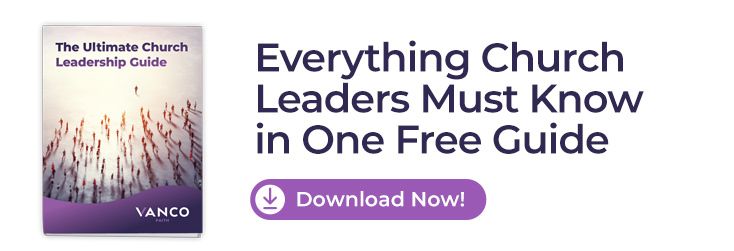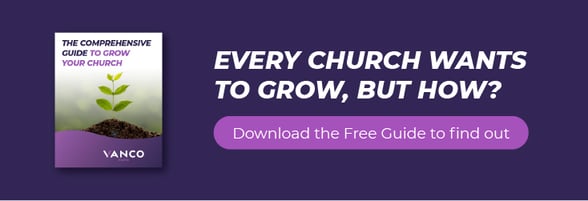
Church board meetings are the heartbeat of church leadership, where decisions shape the future of the congregation. But let’s be honest — meetings can sometimes feel long, unproductive or even disconnected from the church’s mission.
So, what separates a good meeting from a great one? It starts with clear objectives, prayerful guidance and a focus on church governance that aligns with your church’s vision.
Whether you’re a pastor, elder, deacon or church treasurer, this guide will show you how to run meetings that inspire unity, drive growth and strengthen your ministry. Ready to transform your next church board meeting? Let’s dive in.
Table of contents
- What makes a church board meeting effective?
- How to create an engaging agenda for church board meetings?
- What are the essential responsibilities of church board members?
- How to conduct efficient and productive church board meetings?
- How to handle conflicts and promote unity in church board meetings?
- What are some helpful tips for documenting church board meetings?
- How can church board meetings contribute to growth and success?
- Get our FREE church board meeting templates!
Too Busy to Read? Listen to the Key Takeaways
Get the key takeaways by clicking to listen the podcast summary now!
What makes a church board meeting effective?

How do we set clear objectives for each meeting?
Have you ever walked out of a church board meeting wondering if you accomplished anything? You’re not alone. The secret to a productive meeting isn’t just prayer (though that helps) — it’s having clear, measurable objectives.
Instead of a vague agenda like "discuss the budget," try: "Finalize and approve the budget for next quarter’s outreach program." Sharing these objectives ahead of time keeps your church committee focused and prevents those never-ending side discussions.
When everyone knows the goal, decisions happen faster — and with far less coffee consumption. Read more about SMART goals here.
What role do prayer and spiritual guidance play in meetings?
Prayer isn’t just a routine formality — it sets the tone for church leadership and reminds everyone why they’re gathered in the first place. When you begin and end meetings with prayer, you invite God’s wisdom into every discussion, from major church budget decisions and church strategy to whether the annual picnic should have hot dogs or hamburgers.
Bringing in scripture or devotional readings also keeps conversations anchored in faith. When tackling tough topics — like updating church bylaws or navigating church conflict resolution — it helps to ask: Are we seeking God’s will or just trying to win an argument? A simple prayer can shift perspectives and keep the focus on unity rather than personal preferences.
For inspiration, check out this guide to closing prayers.
How can technology enhance the effectiveness of church board meetings?
Church administration meetings can sometimes feel like a test of patience, but technology can change that. Virtual platforms like Zoom or Microsoft Teams allow church committees to meet efficiently, even when members can’t be in the same room. Tools like Google Workspace or Trello help keep the church vision and tasks organized without the endless email chains.
Imagine your church planning team collaborating on a shared Google Doc — everyone can add input, adjust the board agenda and make real-time updates without passing around 30 versions of the same file. But here’s something to consider: Are you using technology to enhance communication or is it just adding more noise? The right tools should simplify discussions, not complicate them.
How can we ensure productivity in church board meetings?
Few things test patience like a church board meeting that drags on with no end in sight. To avoid the dreaded “meeting that could’ve been an email,” set strict time limits for each agenda item. A board agenda isn’t just a suggestion — it’s your best defense against endless tangents.
Assign a facilitator to keep discussions moving and (gently) redirect off-topic debates. Some churches even use a timer, cutting off discussions at 15 minutes per topic. The real question is: if your meeting lasted half as long, would you get just as much done?
What are the key elements of a successful church board meeting?
The best meetings prioritize participation, timely decision-making and follow-through. Was anything accomplished if board members walked away without knowing their next steps? A good rule of thumb: by the end, every action item should have a name and a deadline attached. Otherwise, you’ll be discussing the same topics next month.
How can you measure the effectiveness of our church board meetings?
You're on the right track if no one dreads the next meeting. But how do you know if your church administration meetings are genuinely effective? Post-meeting surveys can reveal whether people feel their time was well-spent — or just spent.
A simple checklist (like the Enhanced Church Meeting Effectiveness Checklist) can help you track whether decisions led to action. If you find that half your agenda items keep getting postponed, ask yourself: are you holding meetings to make decisions or to talk about making decisions?
How do you create an engaging agenda for church board meetings?
Free Agenda Template and Sample
To make your life a little easier, here’s a free agenda template you can tweak as needed. No need to reinvent the wheel!
How do you balance routine updates with strategic discussions?
Routine updates like financials or committee reports are essential, but they don’t have to take over the meeting. Keep them short — think 10 to 15 minutes — and then dive into the real meaty stuff, like strategic planning.
You could allocate 20 minutes for the usual updates, then give 40 minutes to discuss church growth strategies. That way, you’re informed, but your time is spent thinking about the future, not just reviewing the past.
What are the benefits of including a "vision casting" segment in the agenda?
Here’s the trick: a “vision casting” segment helps keep everyone’s eyes on the prize — whether that prize is expanding your church outreach programs or growing your congregation. This part of the meeting ensures that the board stays motivated, aligned and focused on the big picture.
For example, when the pastor shares a vision for the youth ministry or church prayer team, it’s not just talk; it inspires the team and gets everyone moving toward the goal. Plus, it’s a great way to keep the momentum going without sounding like a broken record.
How do you incorporate feedback from previous meetings into the agenda?
When you kick off your next board meeting, revisit those action items from the last one. This way, you're not just running in circles, but making progress. Take volunteer recruitment, for example.
If you set some goals last time, check in to see if any new volunteers have signed up or if you need to shift your strategy. It's a simple way to keep your church governance moving forward, but are you also tracking progress enough to see the bigger picture?
What items should be included in a church board meeting agenda?
You can’t go wrong with the essentials — opening prayer, financial reports, committee updates, new business and closing prayer. For example, if you tackle something like "Review of 2024 budget proposal" under new business, you’re setting the stage for important decisions.
But here’s a question: are you spending enough time on the key items or do you sometimes get lost in the weeds of the less critical stuff during the meeting? It’s essential to focus the most time and energy on important items and relegate less important items to the bottom of your priority list for your church board meeting.
How can we prioritize agenda items for maximum efficiency?
This one’s about being intentional. Consider your agenda like a to-do list — first, tackle the most urgent items. You probably don’t want to put off the discussion about infrastructure if your church roof leaks. For instance, repairs should be much more pressing than reviewing the next church bake sale.
It’s all about focusing on what matters most, but here's something to think about — are we always doing that or are we distracted by the “nice to have” tasks?
What's the best way to distribute the agenda to board members?
Sending an agenda out at the last minute? Not the best idea. Aim for 3-5 days ahead through email or a shared platform so board members have enough time to prepare. A shared Google Drive folder is a great option — it keeps everything in one place. This kind of church communication helps prevent that dreaded “What’s on the agenda again?” moment before the meeting starts.
What are the essential responsibilities of church board members?
How can board members balance their spiritual and administrative roles?
Balancing the spiritual and administrative sides of being a board member is like walking a tightrope — except the rope is made of prayer and church financial planning. You’ve got to be spiritually present for the congregation but also practical regarding church finances, church programs and strategic planning.
It can be a real challenge trying to figure out how you can serve the church without losing your balance between spiritual mentorship and governance. The answer starts with the fact that a good board member knows when to pray for wisdom and when to crunch the numbers.
What are the ethical responsibilities of church board members?
Ethics in church leadership? Clearly, that’s non-negotiable. Your role is built on integrity, confidentiality and keeping personal interests in check. Whether it’s ensuring church transparency or recusing yourself from voting on issues with personal conflict, your ethical duties go hand in hand with your leadership.
Think about it: If you don't hold the line, who will?
How can board members support the pastor and church staff?
Supporting your pastor, church secretary, church treasurer and other church staff isn’t just about rubber-stamping budgets — though those checks don’t write themselves.
It’s about being their biggest cheerleader, whether you’re approving funds for pastoral counseling training or just showing up with coffee and a kind word after a marathon weekend of services. Consider it as being part church treasurer, unofficial therapist and motivational speaker.
How can board members contribute to the church's mission?
Serving on a church board isn’t just about meetings and motions — it’s about making a real impact. Every decision you make shapes the church’s future, from strategic planning to ensuring church finances support meaningful work.
Are you helping drive the mission forward or just approving budgets? Check out this guide on how to craft a mission that genuinely guides your church.
What are the key roles within a church board?
A well-structured church board is a true team where every member has a distinct role, but all work harmoniously. The chairperson keeps discussions on track, the secretary documents meeting minutes and the treasurer (probably your church’s best budget wrangler) ensures financial accountability.
The committee leads tackle areas like worship or outreach programs. Imagine a board meeting where everyone knows their part — sounds refreshing, right? Explore the role of a church board and use this template to define roles in your church.
How can board members prepare for meetings effectively?
Nobody wants to be the one flipping through documents while everyone else is deep in discussion. Reviewing the board agenda beforehand lets you ask thoughtful questions instead of scrambling for context. If the church budget is on the table, know the numbers so you’re not just nodding. Good church leadership starts with good preparation.
How do you conduct efficient and productive church board meetings?
What are the best ways to start and end a meeting on time?
Start when you say you will. End when you say you will. It sounds simple, yet so many church board meetings stretch endlessly. If your board agenda says 6:30-8:00 p.m., stick to it. After all, no one ever said, “I wish that meeting had lasted longer.”
How can the chairperson facilitate discussions effectively?
Leading a discussion isn’t about talking the most — it’s about guiding the conversation. Draw out quieter church members with open-ended questions and when the discussion drifts, bring it back to the main point. If a debate about church finances turns into a deep dive into the color of the new carpet, it’s time for a gentle redirection: “Great thoughts! Let’s save that for the church committee handling renovations.”
What are the signs of an unproductive meeting and how can they be addressed?
If people are zoning out, tensions are rising or the same topics resurface with no resolution, you’ve got a problem. A wandering meeting needs a solid church meeting agenda template and someone willing to keep things moving. Actionable conclusions are key in order to avoid a whole lot of words being said an no actual progress being made month after month.
What are the best practices for running a smooth church board meeting?
A well-run meeting is structured and engaging, leaving people with something to act on. Following church bylaws, sticking to the agenda and encouraging respectful dialogue keep things flowing. Robert’s Rules of Order can help, but common courtesy and a straightforward decision-making process work wonders, too.
How can we manage time effectively during board meetings?
Time is the same as money — everyone appreciates it when it's handled well. Assign clear time limits: 10 minutes for church finances and 20 minutes for strategic discussions. A timekeeper or visible clock helps, but the real trick is keeping conversations focused.
What strategies can help keep board members focused and engaged?
Board meetings can sometimes feel like a test of endurance. Keep things lively with visual aids that break down complex topics (because no one wants to decipher a spreadsheet at 9 p.m.). Short breaks help reset focus and assigning action items ensures the church committee stays accountable.
How do you handle conflicts and promote unity in church board meetings?
What are the biblical principles for resolving conflicts in church settings?
Matthew 18:15-17 isn’t just a nice idea — it’s a lifeline for keeping church governance from turning into a battlefield. When you address a disagreement privately, you give the other person dignity. If that fails, bring in trusted voices. Imagine a church board member skipping these steps and venting in a group email — nothing fuels division faster than a well-timed "Reply All."
How can active listening improve communication during disagreements?
People don’t always want agreement; they want to be heard. Active listening — paraphrasing what someone says before responding — slows the urge to debate. Picture a church treasurer pausing during a heated budget discussion to say, “So, you're not against the purchase — you just want more transparency?” It’s incredible how defusing tension can start with a simple, well-placed question.
What are the consequences of unresolved conflicts in church boards?
Sweeping problems under the rug only guarantees you’ll trip over them later. A fractured church committee leads to stalled projects, lost trust and some members “discerning a call elsewhere.” If a fight over church bylaws gets out of hand, you might spend more time navigating resignations than leading the church.
What techniques can be used to resolve disagreements among board members?
Use mediation, seek common ground and focus on shared goals. Disagreements are inevitable, but division doesn’t have to be. A neutral third party can help untangle the tension when discussions get tangled — like Christmas lights in a storage box. Conflict resolution works best when you focus on what unites you rather than who’s right.
How can we foster a spirit of unity and reconciliation during meetings?
Emphasize the church’s mission, the church strategic plan and the importance of working together. It’s easy to get lost in details, but reminding everyone of the church vision helps realign hearts and minds. Starting with a shared prayer or mission statement shifts the tone — because nothing dissolves tension faster than remembering why you're here in the first place.
What role does the chair play in maintaining harmony in board meetings?
The chair ensures respectful dialogue, manages conflicts and keeps discussions focused. Without this humble leadership, a board agenda can unravel into a theological debate over the coffee budget. A skilled chair redirects discussions before they go off the rails, using church meeting protocols to keep things moving — because nobody wants a meeting that lasts longer than Sunday service.
What are some helpful tips for documenting church board meetings?
How can meeting minutes reflect the spirit and tone of the discussion?
Minutes should capture the heart of the conversation without editorializing. Think of yourself as a historian, not a commentator. Instead of writing, “Everyone was thrilled about the new church outreach programs,” phrase it like, “The church committee discussed and approved the program with enthusiasm.”
The goal? To document the moment without turning the minutes into a novel — or worse, a debate transcript.
[Download Our Free Minutes Template]
What are the legal and compliance considerations for church board minutes?
If a question arises about a church governance decision, clear documentation can resolve it in a timely manner. Store them securely, restrict access to key church staff and keep digital copies in a password-protected folder. Trust us — in the future, you’ll appreciate the foresight.
How do you take effective meeting minutes for church board meetings?
Jot down attendance, summarize discussions and record decisions. For example: “The church treasurer presented the church budget report, followed by a vote on updated church policies. Motion passed unanimously.” There’s no fluff or rambling — just a concise record that keeps church stewardship on track.
What information should be included in board meeting minutes?
Every detail matters. Meeting minutes should capture the date, time, attendees, agenda items, decisions and next steps — not just for record-keeping but for accountability. Example: "Next meeting: Aug. 15, 2025, at 6:30 p.m."
How can we ensure proper review and approval of meeting minutes?
Minutes lose value if they aren’t reviewed. Distribute them within a week and approve them at the next church leadership meeting. Example: The church committee confirms accuracy before moving forward.
How Can Church Board Meetings Contribute to Growth and Success?
How Can Board Meetings Foster Innovation and New Ideas?
When was the last time a meeting sparked real excitement? Setting aside 15 minutes for fresh ideas — like engaging younger members — could turn a routine meeting into a creative powerhouse.
What Role Do Board Meetings Play in Engaging the Broader Church Community?
Ever wonder why some events thrive while others fizzle? A single board decision — like funding a community food drive — can transform church events into powerful outreach opportunities.
How Can Board Meetings Help Identify and Address Challenges in Church Operations?
Ignoring problems won’t make them disappear (unfortunately). Regularly reviewing feedback lets you tackle challenges such as declining attendance head-on, whether through a new worship service or a fresh approach to outreach.
What Strategies Can Boards Use to Drive Church Growth Through Meetings?
Growth doesn’t happen by accident. If your church budget supports a goal to increase membership by 10 percent, every meeting should ask: Are we closer or just doing busy work?
How Can Board Meetings Help Align Church Activities With Its Mission?
Is every program serving your church vision or are some just sailing along or existing because they’ve always been part of your faith community and no one has the heart to ask if they’re still needed? Cutting what no longer fits might be challenging, but clarity fuels real impact.
What Role Do Board Meetings Play in the Overall Success of a Church?
Strong church leadership isn’t about having more meetings — it’s about making the meetings you do have count. Having proper discussions today shapes a thriving, engaged congregation tomorrow.
Get our FREE church board meeting templates!
- Church Meeting Agenda Template – Plan and organize meetings with clarity and structure.
- Church Meeting Minutes Template – Accurately document discussions, decisions, and action items.
- Church Meeting Sign-In Sheet – Track attendance and ensure quorum requirements are met.
- Church Meeting Effectiveness Checklist – Evaluate productivity and identify areas for improvement.
- Church Board Member Portfolio Template – Define roles, responsibilities, and key achievements for leadership clarity.
And That’s Not All...
You’ll also get our comprehensive church leadership guide. 1,255 church leaders have already tried it to improve their management!
Get All the Materials for FREE!
Get the Guide!














